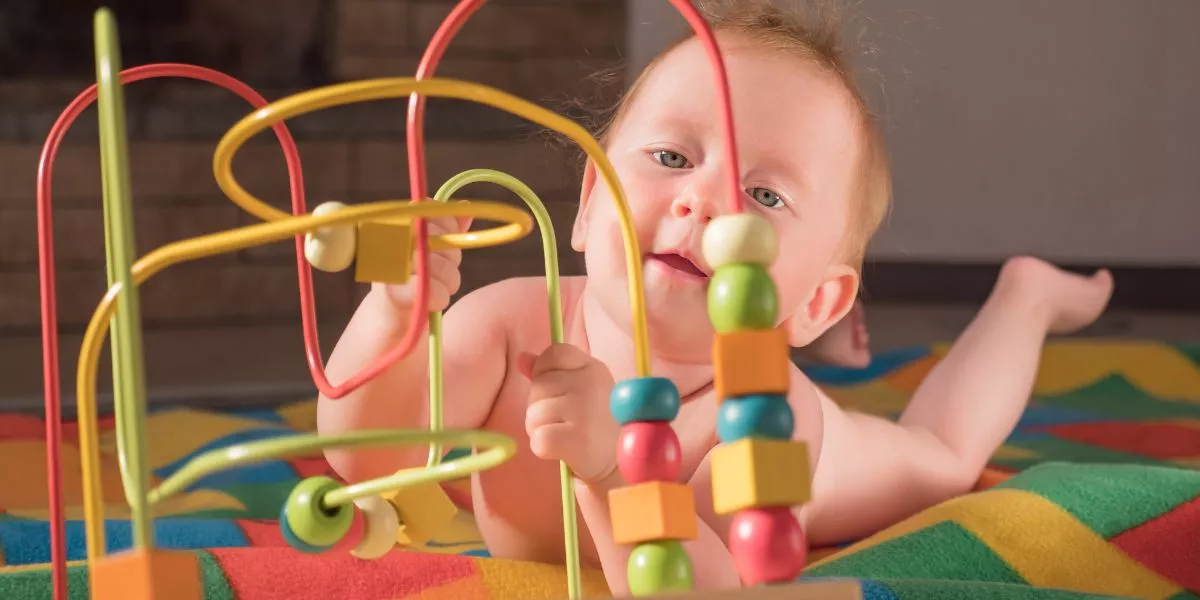When picking toys to boost your infant's fine motor skills, go for different textures, shapes, and safe options that aid in their development. Consider materials and sizes to facilitate grasping, opt for soft or light toys, choose simple shapes, and avoid choking hazards. Opt for toys like stacking rings, shape sorters, textured balls, building blocks, and puzzles to promote hand strength and coordination. Ensure a safe play environment and supervise interactions to guide proper toy use and skill enhancement.
Understanding Infant Fine Motor Development
To better comprehend infant fine motor development, focus on observing their grasp and manipulation skills. Infants start developing these skills soon after birth, with their grasp evolving from a reflexive palmar grasp to a more controlled pincer grasp by around 9-12 months. Initially, babies will use their whole hand to grasp objects, but as they grow, they'll begin using their fingers to pick up small items.
As infants explore their environment, they use their hands to manipulate objects, improving their hand-eye coordination and dexterity. You'll notice them turning objects over, banging them together, and eventually trying to fit shapes into corresponding holes. These actions help strengthen their finger muscles and refine their motor skills.
Factors to Consider When Choosing Toys
When selecting toys for infants to enhance their fine motor skills, consider the materials and sizes that best suit their grasp and manipulation abilities. Opt for toys made of soft fabrics or materials that are easy to hold and manipulate, such as lightweight plastic or wood. These materials are gentle on delicate skin and provide the right amount of resistance for developing muscles.
Additionally, choose toys that are appropriately sized for your infant's hands. Toys that are too small can be frustrating to hold and manipulate, while toys that are too large may be difficult to grasp.
Another factor to consider is the complexity of the toy. For infants, simple toys with basic shapes or textures are ideal for promoting fine motor skills. Toys with buttons, knobs, or moving parts can help develop hand-eye coordination and dexterity. Avoid toys with small parts that could pose a choking hazard.
Types of Toys That Promote Fine Motor Skills
Consider incorporating toys that offer various textures and shapes to stimulate different fine motor skills in infants. Toys like stacking rings, shape sorters, and textured balls can help develop hand-eye coordination, finger dexterity, and grasping abilities.
Stacking rings encourage infants to grasp and stack the rings, improving their hand strength and coordination. Shape sorters promote problem-solving skills as infants figure out which shapes fit into corresponding holes. Textured balls allow infants to explore different tactile sensations, enhancing their sensory development and fine motor skills.
Additionally, toys such as building blocks, nesting cups, and simple puzzles are great for promoting fine motor skills in infants. Building blocks help infants practice grasping and stacking, improving their hand and finger muscles. Nesting cups allow infants to stack, nest, and pour, enhancing hand-eye coordination and fine motor control. Simple puzzles with large, easy-to-grasp pieces encourage problem-solving and hand dexterity.
Safety Tips for Selecting Developmental Toys
Ensure the developmental toys you choose for infants prioritize safety above all else. When selecting toys to promote fine motor skills, opt for items that are free of small parts that could pose a choking hazard. Look for toys with rounded edges and no sharp points to prevent injuries. Ensure that the toys are made of non-toxic materials and are durable enough to withstand rough play without breaking into small, hazardous pieces.
Always check for any potential safety recalls on toys before making a purchase. Additionally, consider the size of the toy – it should be large enough that it can't be swallowed whole. Avoid toys with strings or cords longer than 7 inches, as these can pose a strangulation risk.
Lastly, inspect toys regularly for any signs of wear and tear, and discard or repair damaged toys promptly to prevent accidents. By prioritizing safety when selecting developmental toys, you can provide a secure environment for infants to explore and enhance their fine motor skills.
Incorporating Playtime for Optimal Skill Development
To optimize skill development, engage in interactive playtime sessions with infants. Play is crucial for enhancing fine motor skills in infants. Utilize toys that encourage grasping, reaching, and manipulating objects to support their development. Incorporate activities like stacking blocks, playing with shape sorters, or using toys that involve twisting and turning movements. These interactions help infants strengthen their hand muscles and improve hand-eye coordination.
During playtime, provide a variety of textures for the infant to explore. Offer toys with different surfaces such as soft, rough, smooth, or bumpy to stimulate sensory experiences and refine their tactile abilities. Engaging in sensory play can also aid in the development of fine motor skills by encouraging the use of fingers and hands to explore the environment.
Remember to supervise playtime to ensure safety and to guide the infant in using the toys appropriately. By actively participating in play sessions and introducing toys that promote fine motor skills, you can create a stimulating environment that supports optimal skill development in infants.

